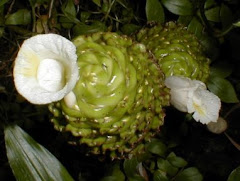



FORMS USED
Whole raw roots are generally referred to as fresh ginger. A piece of the rhizome, called a ‘hand’. It has a pale yellow interior and a skin varying in colour from brown to off-white. Jamaican ginger, which is pale buff, is regarded as the best variety. African and Indian ginger is darker skinned and generally inferior, with the exception of Kenya ginger.
Whole fresh roots provide the freshest taste. The roots are collected and shipped when they are still immature, the outer skin is a light green colour. These can sometimes be found in Oriental markets.
Dried roots are sold either ‘black’ with the root skin left on, or ‘white’ with the skin peeled off. The dried root is available whole or sliced.
Powdered ginger is the buff-coloured ground spice made from dried root.
Preserved or ‘stem’ ginger is made from fresh young roots, peeled and sliced, then cooked in a heavy sugar syrup. The ginger pieces and syrup are canned together. They are soft and pulpy, but extremely hot and spicy.
Crystallized ginger is also cooked in sugar syrup, then air dried and rolled in sugar.
Pickled ginger has the root sliced paper-thin and pickled in a vinegar solution. This pickle is known in Japan as gari, which often accompanies sushi, and is served to refresh the palate between courses.
PREPARATION AND STORAGE
In Asian cooking, ginger is almost always used fresh, either minced, crushed or sliced. Fresh ginger can be kept for several weeks in the salad drawer of the refrigerator. It can be kept for about three weeks in a refrigerator and up to three months in a freezer. Dried ginger should be ‘bruised’ by beating it to open the fibers, then infused in the cooking or making ginger beer and removed when the flavour is sufficient. Store dried and powdered ginger in airtight containers.
USE AND COMMERCIAL IMPORTANCE
Z.officinale have been cultivated for its use as spices, condiments, flavours, fresh vegetables, medicines and as ornamentals. This freshy branched rhizomes are exported to temperate regions from several tropical countries.
CULINARY USES
Z.officinale is valued throughout the world as a spice or flavoring agent. In Arabic and western cooking, dried ginger is mainly used for breads, cookies, cakes, teas, beers and wines, while in most Asian countries such as in India, China, Thailand, Indonesia and Japan, fresh ginger is mainly used as an ingredient for cooking to add a distinctive flavor to a dish. It is indispensable for curry powders and some other spice blends.
In Japan, pickled rhizomes and young ginger shoots are widely used as a garnish. Fresh ginger is essential to Asian and oriental cookery. It is used in pickles, chutneys and curry pastes and the ground dried root is a constituent of many curry powders. Tender young ginger can be sliced and eaten as a salad. Sometimes the roots will produce green sprouts which can be finely chopped and added to a green salad.
Ginger is also used in puddings, jams, preserves and in some drinks like ginger beer, ginger wine and tea. Pickled ginger is a delicious accompaniment to satays and a colourful garnish to many Chinese dishes. Preserved ginger is eaten as a confection, chopped up for cakes and puddings, and is sometimes used as an ice cream ingredient.
Young ginger rhizomes are juicy and fleshy with a very mild taste. They are stewed in boiling water to make ginger tea, to which honey is often added as a sweetener; sliced orange or lemon fruit may also be added. Mature ginger roots are fibrous and nearly dry. The juice from old ginger roots is extremely potent and is often used as a spice in Indian recipes and Chinese cuisine to flavor dishes such as seafood or mutton and vegetarian recipes.
Powdered dry ginger root (ginger powder) is typically used to spice gingerbread and other recipes. Fresh ginger can be substituted for ground ginger at a ratio of 6 parts fresh for 1 part ground, although the flavors of fresh and dried ginger are not exactly interchangeable.
Ginger is also made into candy, is used as a flavoring for cookies, cracker and cake, and is the main flavor in ginger ale—a sweet, carbonated, non-alcoholic beverage, as well as the similar, but spicier ginger beer which is popular in the Caribbean.
Fresh ginger should be peeled before cooking.































































No comments:
Post a Comment